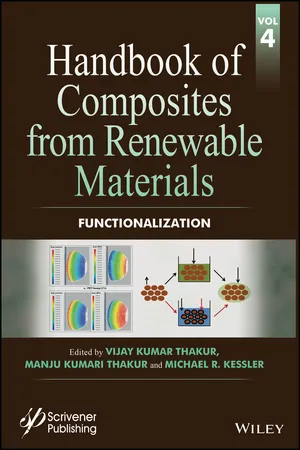
Handbook of Composites from Renewable Materials, Functionalization
- English
- ePUB (mobile friendly)
- Available on iOS & Android
Handbook of Composites from Renewable Materials, Functionalization
About this book
This unique multidisciplinary 8-volume set focuses on the emerging issues concerning synthesis, characterization, design, manufacturing and various other aspects of composite materials from renewable materials and provides a shared platform for both researcher and industry.
The Handbook of Composites from Renewable Materials comprises a set of 8 individual volumes that brings an interdisciplinary perspective to accomplish a more detailed understanding of the interplay between the synthesis, structure, characterization, processing, applications and performance of these advanced materials. The Handbook comprises 169 chapters from world renowned experts covering a multitude of natural polymers/ reinforcement/ fillers and biodegradable materials.
Volume 4 is solely focused on the Functionalization of renewable materials. Some of the important topics include but not limited to: Chitosan-based bio sorbents; oil spill clean-up by textiles; pyridine and bipyridine end-functionalized polylactide; functional separation membranes from chitin and chitosan derivatives; acrylated epoxidized flaxseed oil bio-resin and its biocomposites; encapsulation of inorganic renewable nanofiller; chitosan coating on textile fibers for functional properties; surface functionalization of cellulose whiskers for nonpolar composites; impact of chemical treatment and the manufacturing process on mechanical, thermal and rheological properties of natural fibers based composites; bio-polymers modification; review on fibers from natural resources; strategies to improve the functionality of starch based films; the effect of gamma-radiation on biodegradability of natural fibers; surface functionalization through vapor-phase assisted surface polymerization (VASP) on natural materials from agricultural by-products; okra bast fiber as potential reinforcement element of biocomposites; silane coupling agent used in natural fiber/plastic composites; composites of olefin polymer /natural fibers: the surface modifications on natural fibers; surface functionalization of biomaterials; thermal and mechanical behaviors of bio-renewable fibres based polymer composites; natural and artificial diversification of starch; role of radiation and surface modification on bio-fiber for reinforced polymer composites.
Frequently asked questions
- Essential is ideal for learners and professionals who enjoy exploring a wide range of subjects. Access the Essential Library with 800,000+ trusted titles and best-sellers across business, personal growth, and the humanities. Includes unlimited reading time and Standard Read Aloud voice.
- Complete: Perfect for advanced learners and researchers needing full, unrestricted access. Unlock 1.4M+ books across hundreds of subjects, including academic and specialized titles. The Complete Plan also includes advanced features like Premium Read Aloud and Research Assistant.
Please note we cannot support devices running on iOS 13 and Android 7 or earlier. Learn more about using the app.
Information
Chapter 1
Chitosan-Based Biosorbents: Modifications and Application for Sequestration of PPCPs and Metals for Water Remediation
Abstract
1.1 Introduction
Table of contents
- Cover
- Title page
- Copyright page
- Dedication
- Preface
- Chapter 1: Chitosan-Based Biosorbents: Modifications and Application for Sequestration of PPCPs and Metals for Water Remediation
- Chapter 2: Oil Spill Cleanup by Textiles
- Chapter 3: Pyridine and Bipyridine End-Functionalized Polylactide: Synthesis and Catalytic Applications
- Chapter 4: Functional Separation Membranes from Chitin and Chitosan Derivatives
- Chapter 5: Acrylated Epoxidized Flaxseed Oil Bio-Resin and Its Biocomposites
- Chapter 6: Encapsulation of Inorganic Renewable Nanofiller
- Chapter 7: Chitosan Coating on Textile Fibers for Functional Properties
- Chapter 8: Surface Functionalization of Cellulose Whiskers for Nonpolar Composites Applications
- Chapter 9: Impact of Chemical Treatment and the Manufacturing Process on Mechanical, Thermal, and Rheological Properties of Natural Fibers-Based Composites
- Chapter 10: Biopolymers Modification and Their Utilization in Biomimetic Composites for Osteochondral Tissue Engineering
- Chapter 11: Fibers from Natural Resources
- Chapter 12: Strategies to Improve the Functionality of Starch-Based Films
- Chapter 13: The Effect of Gamma Radiation on Biodegradability of Natural Fiber/PP-HMSPP Foams: A Study of Thermal Stability and Biodegradability
- Chapter 14: Surface Functionalization Through Vapor-Phase-Assisted Surface Polymerization (VASP) on Natural Materials from Agricultural By-Products
- Chapter 15: Okra Bast Fiber as Potential Reinforcement Element of Biocomposites: Can It Be the Flax of the Future?
- Chapter 16: Silane Coupling Agents Used in Natural Fiber/Plastic Composites
- Chapter 17: Composites of Olefin Polymer/Natural Fibers: The Surface Modifications on Natural Fibers
- Chapter 18: Surface Functionalization of Biomaterials
- Chapter 19: Thermal and Mechanical Behaviors of Biorenewable Fibers-Based Polymer Composites
- Chapter 20: Natural and Artificial Diversification of Starch
- Chapter 21: Role of Radiation and Surface Modification on Biofiber for Reinforced Polymer Composites: A Review
- Index
- End User License Agreement